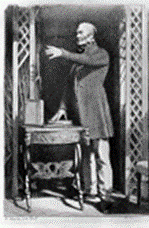Robert Knox
1791-1862
Was a lecturer on anatomy in Edinburgh, where he introduced the theory of transcendental anatomy. He is now mainly remembered for his involvement in the Burke and Hare murders. He contracted smallpox as a child, which destroyed his left eye and disfigured his face. In April 1817, he joined the 72nd Highlanders and sailed with them to South Africa. He enjoyed riding, shooting and the beauty of the landscape with which he felt in spiritual harmony—an early expression of his transcendental world view. Knox developed an interest in observing racial types and disapproved of what he saw as the Boers' contempt for the indigenous peoples. Relations with Boer officer and future Governor were marred when Knox accused his brother of theft. A court martial acquitted the accused and one of the officer’s supporters, named Burdett, challenged Knox to a duel. Knox initially refused to fight, and Burdett "soundly horse whipped him on the parade before every Officer of the Garrison." Knox then grabbed a sabre and inflicted a slight wound to Burdett's arm. Knox's promotion to Assistant Surgeon was cancelled and he returned to Britain in disgrace, arriving on Christmas Day 1820. The following October, he went to Paris to study anatomy for just over a year. It was then that he met both Georges Cuvier and Étienne Geoffroy Saint-Hilaire, who were to remain heroes for his entire life. Knox returned to Edinburgh by Christmas 1822 and in 1823 he was elected a Fellow of the Royal Society of Edinburgh. Soon after his election he submitted a plan to the Royal College of Surgeons of Edinburgh for a Museum of Comparative Anatomy, which was accepted, and on 13 January 1825 he was appointed Curator of the museum with a salary of £100. In 1825, John Barclay offered him a partnership at his anatomy school in Surgeon's Square, Edinburgh. In order for his lectures to be recognised by the Edinburgh College of Surgeons, Knox had to be admitted to its fellowship; a formality, but, at £250, an expensive one. At this time most professorships were in the gift of the town council, resulting in such uninspiring teachers as the professor of anatomy, Alexander Monro. This created a demand for private tuition, and the flamboyant Knox—in sole charge after Barclay's death in 1826—had more students than all the other private tutors put together. He turned his sharp wit on the elders and the clergy of the city, satirising religion and delighting his students. Little is known of Knox's wife, Susan Knox, whom he married in 1824.According to Knox's friend Henry Lonsdale the marriage was kept secret as she was 'of inferior rank.' During his time in Edinburgh, Knox lived at 4 Newington Place with his sisters Mary and Jessie, while Susan and his four children lived at Lilliput Cottage in Trinity, west of Leith. They had seven children, but only two of them survived into adulthood. Before the Anatomy Act of 1832, the main legal supply of corpses for anatomical purposes in the UK were those condemned to death and dissection by the courts. This led to a chronic shortage of legitimate subjects for dissection, and this shortage became more serious as the need to train medical students grew, and the number of executions fell. As a consequence, bodysnatching became prevalent and in 1828 Burke and Hare were caught and tried for murdering victims and supplying their corpses to Knox. Knox was not prosecuted, which outraged many in Edinburgh. His house was attacked by a mob and windows were broken. A committee of the Royal Society of Edinburgh exonerated him on the grounds that he had not dealt personally with Burke and Hare, but there was no forgetting his part in the case, and many remained wary of him. Almost immediately after the case, the Royal College of Surgeons of Edinburgh began to harry him, and by June 1831 they had procured his resignation as the Curator of the museum he had proposed and founded. In the same year he was obliged to resign his army commission to avoid further service in the Cape. This removed his last source of guaranteed income, but fortunately his classes were more popular than ever, with a record 504 students. His school moved to the grander premises of Old Surgeons' Hall in 1833 but his class declined after Edinburgh University made its own practical anatomy class compulsory in the mid-1830s. In 1837 Knox applied for the chair in pathology at Edinburgh University but his candidature was blocked by eleven existing professors, who preferred to abolish the post rather than appoint him. In 1842 he was unable to make payments to the Edinburgh funerary system, from which bodies were supplied to private schools, and he relocated to Glasgow where, still short of subjects for dissection, he closed his school in 1844. In 1847 the Royal College of Surgeons of Edinburgh found him guilty of falsifying a student's certificate of attendance and refused to accept any further certificates from him, effectively banning him from teaching in Scotland. In the same year he was expelled from the Royal Society of Edinburgh and had his election retrospectively cancelled. Knox left for London after the death of his wife (the remaining children were left with a nephew). He found it impossible to find a university post, and from then until 1856 he worked on medical journalism, gave public lectures, and wrote several books, including his most ambitious work, The Races of Men in which he argued that each race was suited to its environment and "perfect in its own way." His book about fishing sold best. In 1854 his son Robert died of heart disease; Knox tried for a posting to the Crimea but at 63 was judged too old. In 1856 he became the pathological anatomist to the Free Cancer Hospital, London. He joined the medical register at its inception in 1858 and practiced obstetrics in Hackney until shortly before his death on 20 December 1862.
